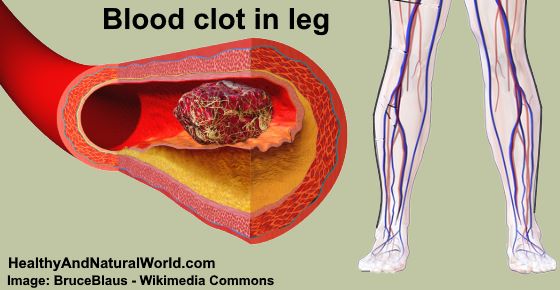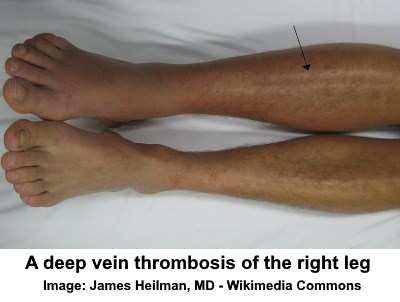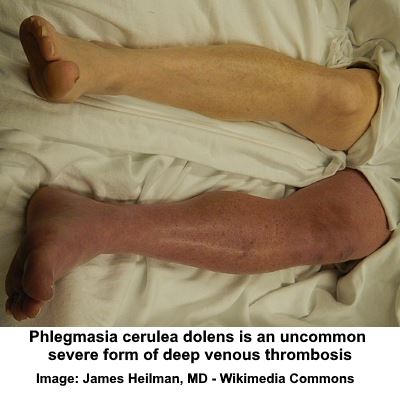Blood Clot in Leg: Signs and Symptoms You Shouldn’t Ignore (Pictures Included)

A blood clot in your leg that is associated with deep vein thrombosis (DVT) can cause your lower leg to be sore, swollen, and red. A blood clot that develops deep in the veins of one of your legs can result in serious complications. If the leg clot doesn’t dissolve naturally, it can travel through your veins, eventually reaching your lungs and cause a pulmonary embolism.
Blood clots form in the legs due to poor circulation, injury to the veins, a side effect of medication, or complication after surgery. Sitting for long periods of time when flying or driving can also increase your risk of deep vein thrombosis. Because of the potentially fatal complications of a blood clot deep in a vein, you should never ignore signs of DVT.
In this article, you will find out how to spot the symptoms of a dangerous blood clot in your lower leg. You will also learn what you can do to prevent deep leg clots and how to avoid the complications of deep vein thrombosis.
What is a Blood Clot?
The medical term for a blood clot is a thrombus, and a blood clot deep in the vein of the legs is referred to as venous thrombosis.
The journal Annual Review of Fluid Mechanics says that a blood clot is a congealing of platelets that stick together to form a thick mass. Doctors say that deep vein blood clots in the leg mainly occur because of a lack of movement or a genetic factor.1
Although blood clotting is necessary to prevent excess bleeding, blood clots that form in veins can be dangerous. In fact, a blood clot can kill a person if part of it breaks off and reaches the lungs, heart, or brain.1
Why Are Blood Clots Dangerous?
The existence of a venous clot in your lower leg or upper thigh won’t in itself harm you. Blood clots that don’t dissolve on their own only become dangerous when they start to move around the cardiovascular system.
According to doctors on PubMed Health, deep vein thrombosis can cause a pulmonary embolism (PE). This is when an embolus (part of the leg clot that breaks off) blocks an artery in the lungs. This greatly reduces oxygen supply to tissues in your body, and the complications of the blood clot can fatal.2
What Causes Blood Clots in Leg?
Blood clots that develop in deep veins in your calf are usually caused by conditions that interfere with your blood circulation.
According to Dr. John P. Cuhna on eMedicineHealth, the main causes of deep vein thrombosis are:3
Sitting for a long time. The Centers for Disease Control and Prevention says that traveling for longer than 4 hours on an airplane, in the car, or bus can increase the risk of leg clots in your calves.4
Prolonged bed rest. Being immobile while recovering from an illness or surgery can cause clots to form in your lower limbs.
Surgery. Doctors from the National Health Service report that deep vein blood clots can still form up to 3 months after surgery. Some reports indicate that the risk of DVT could be as high as 70% if measures to prevent blood clots forming aren’t taken.5
Injury to your legs. Research has shown that even minor leg injuries can increase the risk of leg clots developing by 3 times. Having your leg in a cast or undergoing leg surgery significantly increases your risk of DVT.6
Other factors like obesity, pregnancy, cardiac condition, or use of birth control pills are also mentioned among the causes of blood clots in the legs.
What Does a Blood Clot in the Leg Feel and Look Like?
A blood clot deep in the veins of your lower leg can feel like your calf is swollen and aches a lot. Some people describe the pain from a leg clot as feeling like a pulled muscle. Depending on where the blood clot is in your calf, you could feel aches and pain in the back of your leg or have sharp pain in your inner thigh.
Another way to tell if you have a blood clot in your leg is if the leg feels warm and itchy. Although you can’t see what the blood clot looks like, your lower leg may appear red or have a bluish tinge and look slightly swollen. Usually the symptoms of a blood clot in the leg affect only one leg.
You may feel a blood clot moving in your leg if you start to get sudden chest pains and shortness of breath. You may feel the blood clot pain is constant, and if you have any of these serious DVT symptoms, you must call a doctor immediately.
Symptoms and Signs of Blood Clot in Leg
Let’s look in more detail at the various symptoms associated with deep vein thrombosis and when you should seek medical treatment for the leg clot.
Swelling in calf
Noticing swelling in one calf could be a sign that you have a dangerous blood clot in large veins in your leg.
Doctors from the National Health Service report that swelling is often a symptom of deep vein thrombosis. The reason for swelling is that the blood clot prevents blood from flowing back up to your heart. This can result in swelling at the back of your legs or ankles.7
One of the blood clot symptoms is swollen foot along with pain, aching, and tenderness of the calf.
Leg pain in calf
If a blood clot in your leg doesn’t go away naturally but continues to develop, you will start to have pain in your lower legs. The pain of the blood clot may start off as a dull ache and gradually intensify as the clot grows.
According to doctors from the Mayo Clinic, pain and swelling of one of your legs are common if you have a serious blood clot. The leg pain usually starts off in the back of your lower leg and then begins to feel like a cramping ache. Very often, the cramping pain in your leg will be worse during the night.8
Leg pain along with calf swelling for no reason at all is a serious type of pain that you should never ignore. Other reasons for sore leg muscles for no apparent reason include a pulled hamstring or calf muscle, sciatica, varicose veins, or fibromyalgia.
Aching pain when bending your foot
As well as causing pain in the back of your leg, a stubborn blood clot in your calf can cause more pain when you bend your foot.
According to doctors from the Mayo Clinic, you can tell if your leg pain is caused by a deep venous clot if the leg pain worsens as you bend your foot towards your knee.7
Calf tenderness
Along with painful swelling where the blood clot is located, your calf muscle may be tender to touch.
The Western Journal of Medicine reports that a swollen lower limb caused by DVT will also cause tenderness. The tenderness is localized to the part of the leg where the clot is. In fact, tenderness and pain of the calf are among the first signs of DVT that indicate you should seek medical attention.9
Redness on back of leg below your knee
A clot that forms in your leg and doesn’t dissolve on its own will cause your calf muscle to look red and tender.
If you look at pictures of blood clots in leg, you will often see a red patch of skin. Researchers from the Centers for Disease Control and Prevention say that redness of the skin is among the common symptoms of DVT.10
Also, doctors from the Mayo Clinic report that redness of the skin on your calves is also a sign of a blood clot in the veins closer to the surface of the skin. This is a condition called thrombophlebitis and also characterized by redness and swelling of the upper leg or lower leg. These kind of blood clots are common in people with varicose veins.11
In fact, a study published in the journal Vasa showed that having varicose veins puts you at a greater risk of developing deep vein thrombosis.16
Warmth in lower leg
If a blood clot forms in your upper thigh or lower leg and blocks one of your deep veins, your skin may feel warm to touch.
Dr. Kuashal Patel, who is a vascular surgeon at Kaiser Permanente Los Angeles Medical Center, says that the location of the leg clot usually feels warm. This can be a warning sign that this is thrombosis of the veins.12
The book Informed Health Online says that, in time, the warm area around the blood clot could start to tingle, become itchy and develop into a rash.17
Skin discoloration
Venous thrombosis in one or both of your legs can cause the back of your leg to become discolored.
The journal Techniques in Vascular and Interventional Radiology reports that DVT often results in skin discoloration.13 As already mentioned, warmth and redness are often associated with deep vein blood clots. However, researchers from Frankel Cardiovascular Center say that hyperpigmentation can be a complication of DVT. This can result in dry flaky skin that is prone to ulceration because of poor circulation.14
Upper thigh pain because of blood clot
A venous clot deep in the major veins of your leg can also happen near your pelvic area and cause upper thigh pain.
Dr. Kuashal Patel (quoted earlier) says that usually the pain of a deep venous blood clot in the leg is localized to the calf muscle. However, in some cases, you can feel the pain right up to your inner thigh.12
In fact, in some cases, symptoms of deep vein thrombosis can feel like a pulled muscle in the back of the leg (your hamstring).15
Complications of DVT in Leg
Thrombosis of the leg doesn’t always cause any complications because the clot can dissolve on its own. However, if you notice signs of a deep venous clot, you are at risk of developing serious complications of deep vein thrombosis.
Pulmonary embolism
If part of the blood clot breaks off and reaches your lungs, you could suffer from pulmonary embolism (or, pulmonary thromboembolism). This is one of the most serious complications of DVT.
Dr. Daniel R. Ouellette, who specializes in pulmonary care, says that large thrombi can get stuck in the main arteries of the lung. This causes a lack of adequate blood flow to the essential organs in the body. If the pulmonary embolism is not treated promptly, the result could be fatal.18
The main symptoms of pulmonary embolism include:
- Sudden unexplained chest pain that may feel like you’re having a heart attack
- Upper abdominal pain
- Coughing up blood
- Abnormally low blood pressure
- Flank pain
- Difficulty breathing and wheezing
Diagnosing a pulmonary embolism can be difficult because the symptoms are common to many other health conditions. Dr. Daniel R. Ouellette says that chest pain with tenderness may be the main symptom of a pulmonary embolism.
Postthrombotic syndrome
Another long-term complication of deep vein thrombosis is a condition called postthrombotic syndrome. This DVT complication occurs when the clump of blood blocks the artery and damages the vein.
According to the journal JAMA, postthrombotic syndrome may show symptoms years after the thrombosis occurred. Symptoms of postthrombotic syndrome can include:19
- Discoloration of the skin due to hyperpigmentation
- Signs of venous insufficiency like large dark patches of skin that affect the feet and lower leg
- Skin sores and ulcers that have difficulty healing
- Varicose veins
- Heaviness of the legs
- Mild to severe itching in the calves and lower legs
Treatments of Blood Clot in Leg
What are the treatment options if your doctor diagnoses a blood clot that is causing deep vein thrombosis?
Medication
Usually, medication is required to prevent the symptoms and complications associated with DVT.
Dr. James Beckerman on WebMD says that blood thinning medication helps to prevent the clot from breaking off or growing. Anticoagulants also prevent the formation of new deep venous blood clots. In time, the blood clot in your leg will dissolve and disappear. Some types of blood thinners that are prescribed include heparin, warfarin, or Xa inhibitors.20
In serious cases of DVT where there is a risk of pulmonary embolism, your doctor may blast the blood clot using a catheter. The catheter administers drugs directly to the clot to help dissolve the clot and break it up.
Pictures of Blood Clot in Leg
Let’s look at pictures of blood clots in the lower leg. These images can help you visualize how the symptoms of DVT manifest themselves.
How to Prevent Blood Clot in Leg
The best way to avoid any complication of venous clots is to live a healthy lifestyle to prevent clots from forming. In fact, doctors on PubMed Health say that blood clots rarely cause problems in healthy people.2
Exercise regularly
Regular exercise can help to prevent blood clots from forming because it helps to improve your blood circulation naturally.
The journal Thrombosis Research reports that people who have signs of deep vein thrombosis can improve their condition with physical exercise. Various scientific trials have shown that daily walking or running on a treadmill improved the symptoms of DVT. Researchers concluded that walking helps to improve DVT symptoms after surgery and may prevent postthrombotic syndrome.21
Walking daily won’t just help improve symptoms of deep vein thrombosis. Increasing the amount you walk every day can also help you lose weight and improve your general health.
Healthy diet
Sticking to a healthy diet can also help prevent problems with a clot in deep veins in your legs because DVT is associated with obesity.
The journal Open Journal of Preventative Medicine reports that people who are overweight or obese have a greater risk of deep vein thrombosis and pulmonary embolism. Obesity increases pressure on your lower limbs and makes it harder for the blood to return to the heart. Also, having too much belly fat could also be a contributing factor.22
To help you lose weight and keep the weight off, please read my article on 12 simple tweaks for weight loss.
Ginger
Increasing your consumption of ginger can help prevent more blood clots forming because ginger has blood thinning properties.
Research in the journal PLoS One found that ginger affects the production of platelets and can help reduce blood coagulation. This means that ginger can prevent blood clots from forming and help reduce the risk of DVT. However, the study pointed to the fact that ginger may interact with blood-thinning drugs and ginger supplements shouldn’t be used by people who have low platelet count.23
When to See a Doctor
Because deep vein thrombosis can have serious and potentially fatal consequences, you should seek emergency medical help if you have any of its symptoms. Doctors from the Mayo Clinic say that the signs of possible serious complications of DVT are:8
- Unexplained swelling in your calf muscle that is sore and red
- Warmth in your lower leg
- Chest pain that comes on suddenly or intensifies when you breathe deeply
- Coughing up pinkish sputum with streaks of blood
- A rapid pulse
- Dizziness or feeling lightheaded
Related articles:
- 16 Warning Signs of Poor Blood Circulation
- How to Improve Blood Circulation Naturally
- Top 10 Natural Remedies for Swollen Ankles, Legs and Feet
Medical Sources


